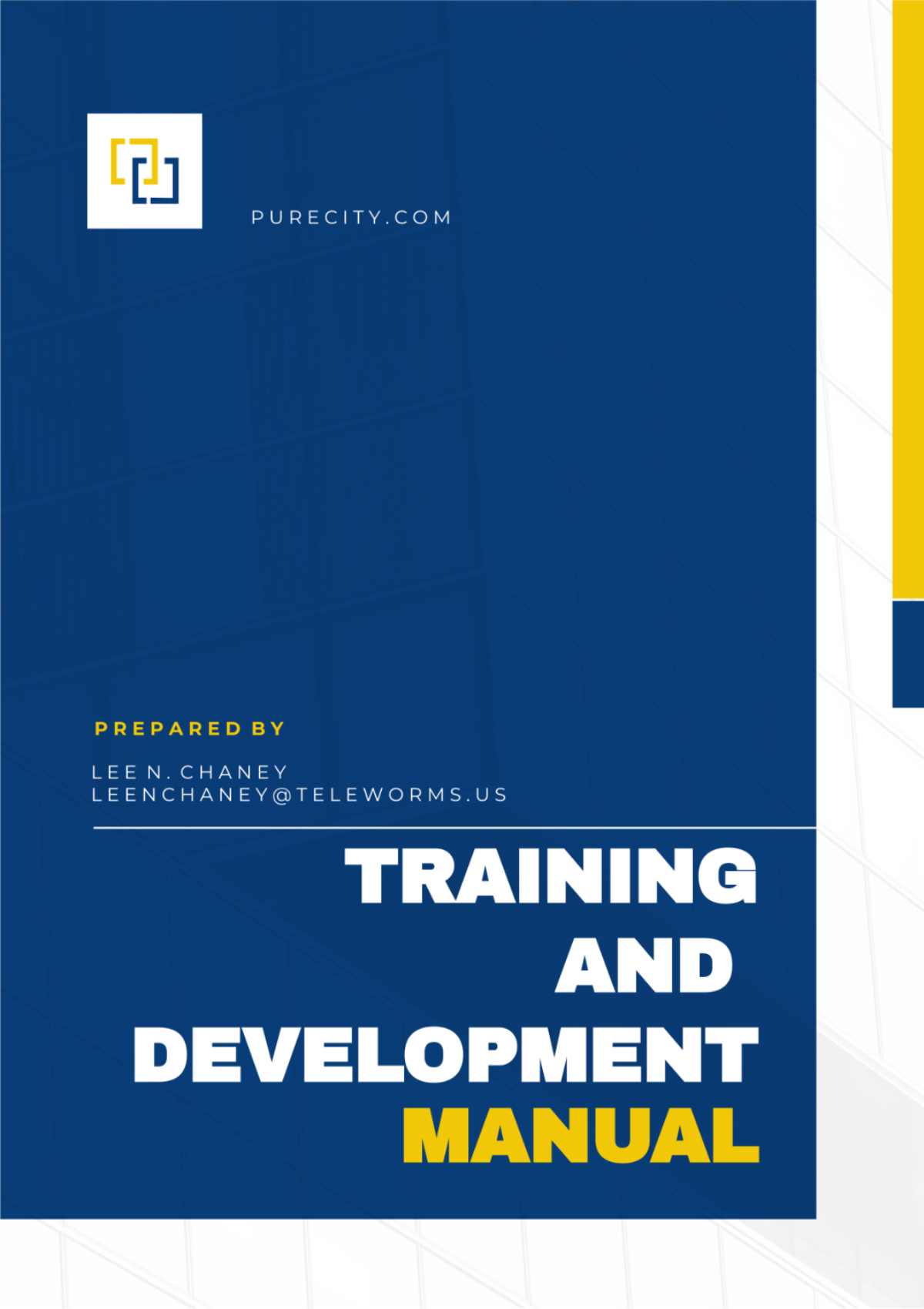Training and Development Manual
Name | [YOUR NAME] |
|---|
Company | [YOUR COMPANY NAME] |
|---|
Department | [YOUR DEPARTMENT] |
|---|
Date | [DATE] |
|---|
I. Introduction
The [YOUR COMPANY NAME] Training and Development Manual serves as a comprehensive guide for fostering employee growth and enhancing organizational performance through structured training initiatives. This manual outlines the policies, procedures, and guidelines governing the training and development process within [YOUR COMPANY NAME]. It is designed to ensure that all employees have access to opportunities for continuous learning and professional advancement, ultimately contributing to the achievement of organizational goals.
A. Purpose
The primary purpose of this manual is to establish a framework for implementing effective training and development programs that align with the strategic objectives of [YOUR COMPANY NAME]. By investing in the growth and development of our employees, we aim to enhance their skills, knowledge, and capabilities, thereby driving innovation, productivity, and employee satisfaction.
B. Scope
This manual applies to all employees, managers, supervisors, and HR professionals involved in planning, implementing, and overseeing training and development activities within [YOUR COMPANY NAME]. It encompasses various aspects of the training process, including needs assessment, program design, delivery methods, evaluation techniques, and career development opportunities.
II. Training Needs Assessment
A. Identifying Training Needs
Effective training programs begin with a thorough assessment of organizational and individual training needs. [YOUR COMPANY NAME] utilizes various methods, such as employee surveys, performance evaluations, and skill gap analyses, to identify areas where training interventions are necessary.
B. Prioritizing Training Initiatives
Once training needs are identified, they are prioritized based on their alignment with organizational objectives and the potential impact on performance improvement. Prioritization ensures that resources are allocated effectively to address the most critical training needs first.
III. Training Program Design
A. Learning Objectives
[YOUR COMPANY NAME]'s training programs are designed with clear and measurable learning objectives that outline the desired outcomes of the training. These objectives serve as a guide for developing content and assessments that align with the intended learning outcomes.
B. Curriculum Development
The development of training curriculum involves selecting appropriate content, instructional methods, and materials to facilitate learning. [YOUR COMPANY NAME] emphasizes the use of interactive and engaging instructional techniques to enhance participant engagement and knowledge retention.
IV. Training Delivery Methods
A. Instructor-Led Training (ILT)
Instructor-led training involves face-to-face delivery of content by a qualified trainer. ILT sessions may be conducted in classrooms, conference rooms, or virtually through webinars or video conferencing platforms.
B. Online Learning
[YOUR COMPANY NAME] also offers online learning opportunities, allowing employees to access training materials and complete modules at their own pace and convenience. Online learning platforms may include interactive modules, videos, quizzes, and discussion forums.
V. Training Evaluation and Feedback
A. Evaluation Criteria
Evaluation criteria are established to assess the effectiveness of training programs in achieving their objectives. [YOUR COMPANY NAME] utilizes various evaluation methods, including pre- and post-training assessments, skills demonstrations, and participant feedback surveys.
B. Feedback Mechanisms
Feedback mechanisms are implemented to gather input from participants regarding their training experience. This feedback is used to identify areas for improvement in training content, delivery methods, and facilitation techniques.
VI. Career Development Opportunities
A. Career Pathways
[YOUR COMPANY NAME] provides employees with clear career pathways outlining potential advancement opportunities within the organization. These pathways may include lateral moves, promotions, and specialized training programs to support career progression.
B. Professional Development Resources
Employees are encouraged to take advantage of professional development resources, such as mentorship programs, tuition reimbursement, and industry certifications, to enhance their skills and knowledge in their respective fields.
VII. Training Records Management
A. Recordkeeping Procedures
[YOUR COMPANY NAME] maintains accurate records of employee training activities, including attendance, completion certificates, and assessment results. These records are stored securely and accessible to authorized personnel for auditing and reporting purposes.
B. Compliance Tracking
Training records are regularly reviewed to ensure compliance with regulatory requirements and organizational policies. Any gaps or deficiencies in training compliance are identified and addressed promptly to maintain regulatory compliance and mitigate risks.
VIII. Continuous Improvement
A. Performance Monitoring
The effectiveness of training programs is monitored continuously through performance metrics, feedback, and evaluation data. This information is used to identify areas for improvement and refine training strategies to better meet the needs of employees and the organization.
B. Program Enhancement
Based on feedback and performance data, [YOUR COMPANY NAME] continuously enhances training programs to ensure they remain relevant, engaging, and effective. This may involve updating content, incorporating new technologies, or introducing innovative training methods.
IX. Training Policy Compliance
A. Policy Review
Regular reviews of training policies are conducted to ensure alignment with organizational goals, industry standards, and regulatory requirements. Any updates or revisions to training policies are communicated to all relevant stakeholders.
B. Policy Adherence
Employees are expected to adhere to all training policies and procedures outlined in this manual. Failure to comply with training policies may result in disciplinary action, up to and including termination of employment.
X. Conclusion
The [YOUR COMPANY NAME] Training and Development Manual serves as a cornerstone for fostering a culture of learning and growth within the organization. By providing structured training programs, career development opportunities, and a commitment to continuous improvement, [YOUR COMPANY NAME] empowers its employees to reach their full potential and contribute to the success of the organization.
Manual Templates @ Template.net






























